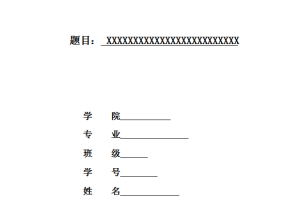Contents
Acknowledgements········································································ Ⅰ
Abstract in English······································································· Ⅱ
Abstract in Chinese······································································· Ⅲ
Introduction··················································································· 1
Chapter One: Introduction of Toni Morrison and Beloved·········· 5
1.1 A Short Introduction of Toni Morrison and Her Works············· 5
1.2 The Background of Beloved··············································· 7
1.3 The Story of Beloved························································ 8
Chapter Two:Community Lost··················································· 11
2.1 The Clearing··································································· 11
2.1.1 The Clearing and Baby Suggs’ Imagined Community········ 11
2.1.2 Sethe and the Clearing··············································· 13
2.2 The Tragedy of Sethe······················································· 15
Chapter Three: Deep Reasons for the Loss of Community·········· 18
3.1 Envy and Pride······························································· 18
3.1.1 Envy····································································· 19
3.1.2 Pride····································································· 22
3.2 The System of Slavery······················································ 23
3.3 Reciprocity···································································· 27
Chapter Four: Reintegration·························································· 30
4.1 The Role of Denver in Reintegration···································· 30
4.1.1 Denver’s Sacrifices·················································· 30
4.1.2 Denver’s Heroic Status·············································· 31
4.2 The Efforts of the Community············································ 35
4.3 The Role of Beloved in Reintegration··································· 38
Conclusion······················································································ 40
Bibliography····································································· 42
Abstract
The themes of racial oppression and community play an important role in African American writers’ fictions. Few American writers, however, have written about community with the consistency and commitment as Morrison does. Calls for the return to home and to community are longstanding themes of Morrison’s works. With the thematic prominence of African American community in her works, Morrison critically explores the possibilities and limitations of community as a sanctuary from overt social oppression.
Through analyzing the inclusion and exclusion of the community in Beloved, Morrison shows how homes and communities serve as places for African Americans to gather strength, formulate strategy, and rest, even as they are insufficient to the task of “solving” institutional and social ills.
The history of racism in the United States makes it imperative for black Americans to resist racial oppression through collective acts of affirmation, empowerment, and resistance. For Morrison, the sites for such acts are the family and the community. In Beloved, Morrison adopts the historical genre of the slave narrative to reconstruct the traumatic history of slavery in the interests of present and future African American community.
The thesis examines Morrison’s literary construction of community in Beloved, discloses slavery and white oppression as the roots of violence in African American community and shows how African Americans developed their sense of community through the bond of the struggle.
Key Words: community, violence, slavery, reintegration
提要
种族压迫和共同体这两个主题在非裔美国作家的小说中起着非常重要的作用,然而,几乎没有任何一个美国作家能像托尼·莫里森那样持之以恒地把回归家园和共同体作为永恒的主题。以非裔美国共同体作为她的重要主题, 托尼·莫里森探索了共同体作为躲避外界社会压迫的避难所的可能性和局限性。
通过分析共同体的包容性和排斥性,莫里森揭示了非裔美国人可以在家园和共同体里获得力量和休息,即使它们并不足以解决社会弊端。
本文揭示了奴隶制度和白人社会的压迫才是非裔美国黑人暴力的根源,同时显示了非裔美国人是如何通过斗争来逐步形成他们的共同体。
关键字:群体,暴力,奴隶制,重建





